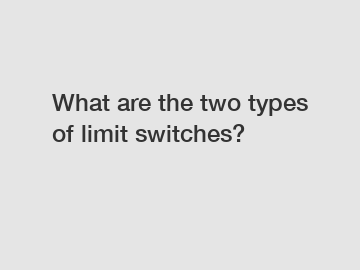What are the two types of limit switches?
What Are the Two Types of Limit Switches?
Limit switches are crucial components used in various industries and applications to detect the presence or absence of objects or to control machinery operation. These switches provide reliable and accurate feedback, ensuring safe and efficient automation processes. Among the different types of limit switches, two key categories stand out: mechanical limit switches and proximity limit switches.
2. Mechanical limit switches:

Mechanical limit switches are widely used in industrial settings due to their robustness and durability. They consist of a lever arm that is mechanically actuated by the object it comes in contact with. This type of switch is commonly found in applications where physical contact with objects is required for detection. Mechanical limit switches are suitable for use in harsh environments that may involve extreme temperatures, high vibration levels, or exposure to contaminants.
3. Types of mechanical limit switches:
a. Rotary limit switches: These switches use a rotary motion to actuate the switch. They are typically used in applications where a lever arm motion is not feasible or efficient. Rotary limit switches find applications in cranes, conveyors, and other mechanisms that require rotational motion detection.
b. Linear limit switches: As their name suggests, linear limit switches are designed to detect linear motion. They have a lever arm that moves in a straight line to trigger the switching action. Linear limit switches are commonly used in industrial machinery, such as elevators, where linear movement needs to be detected for safe and controlled operation.
4. Proximity limit switches:
Proximity limit switches, also known as non-contact limit switches, use various technologies to detect the presence of objects without physical contact. These switches are often preferred in applications where physical contact might cause damage or wear to the switch or the object being detected. Proximity limit switches provide a longer lifespan due to their non-contact nature, making them suitable for applications with high cycle rates or demanding environments.
5. Types of proximity limit switches:
a. Inductive proximity switches: Inductive limit switches detect metal objects using electromagnetic induction. When a metal object comes within the detection range of the switch, it induces eddy currents, triggering the switch's response. These switches are commonly used in manufacturing processes where metal part detection is essential, such as assembly lines or material handling applications.
b. Capacitive proximity switches: Capacitive limit switches detect the presence of any object that has a higher dielectric constant than the surrounding medium. They work based on the principle of changes in capacitance when an object enters their detection range. Capacitive limit switches are often used in industries like food processing, packaging, and pharmaceuticals to detect non-metallic objects.
6. Advantages and considerations:
Both mechanical and proximity limit switches offer unique advantages and considerations that should be taken into account when choosing the appropriate switch for a specific application:
- Mechanical limit switches:
- Advantages: Robustness, reliability, and ability to withstand harsh environments.
- Considerations: May require regular maintenance, potential for wear and tear due to physical contact, limited lifespan in high-cycle applications.
- Proximity limit switches:
- Advantages: Non-contact detection, longer lifespan, suitable for applications with high cycle rates or contamination concerns.
- Considerations: Sensitive to environmental factors like temperature, humidity, and electromagnetic interference, may require more precise installation and alignment.
7. Conclusion:
In conclusion, limit switches play a vital role in automation processes by providing accurate and reliable feedback. The two main types of limit switches, mechanical and proximity, offer distinct detection methods suitable for various industrial applications. Mechanical limit switches excel in rugged environments that require physical contact detection, while proximity limit switches provide non-contact detection options with a longer lifespan. When selecting a limit switch, it is essential to consider the specific application requirements, environmental factors, and desired lifespan to ensure optimal performance and safety.
The company is the world’s best China Limit Switch Company, Sealed Plunger Actuator Limit Switch for Sale, What is an Example of a Limit Switch? supplier. We are your one-stop shop for all needs. Our staff are highly-specialized and will help you find the product you need.

Comments
0